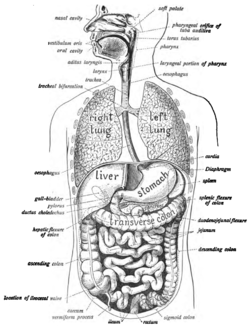Accessory organs of digestion
| Human digestive system | |
|---|---|

Human digestive system
|
|
| Details | |
| Identifiers | |
| Latin | Systema digestorium |
| MeSH | D004064 |
| TA | A05.0.00.000 |
| FMA | 7152 |
|
Anatomical terminology
[]
|
|
The human digestive system consists of the gastrointestinal tract plus the accessory organs of digestion (the tongue, salivary glands, pancreas, liver, and gallbladder). In this system, the process of digestion has many stages, the first of which starts in the mouth. Digestion involves the breakdown of food into smaller and smaller components, until they can be absorbed and assimilated into the body.
Chewing, in which food is mixed with saliva begins the process of digestion. This produces a bolus which can be swallowed down the oesophagus and into the stomach. Here it is mixed with gastric juice until it passes into the duodenum where it is mixed with a number of enzymes produced by the pancreas. Saliva also contains a catalytic enzyme called amylase which starts to act on food in the mouth. Another digestive enzyme called lingual lipase is secreted by some of the lingual papillae on the tongue and also from serous glands in the main salivary glands. Digestion is helped by the mastication of food by the teeth and also by the muscular actions of peristalsis and segmentation contractions. Gastric juice in the stomach is essential for the continuation of digestion as is the production of mucus in the stomach.
...
Wikipedia
